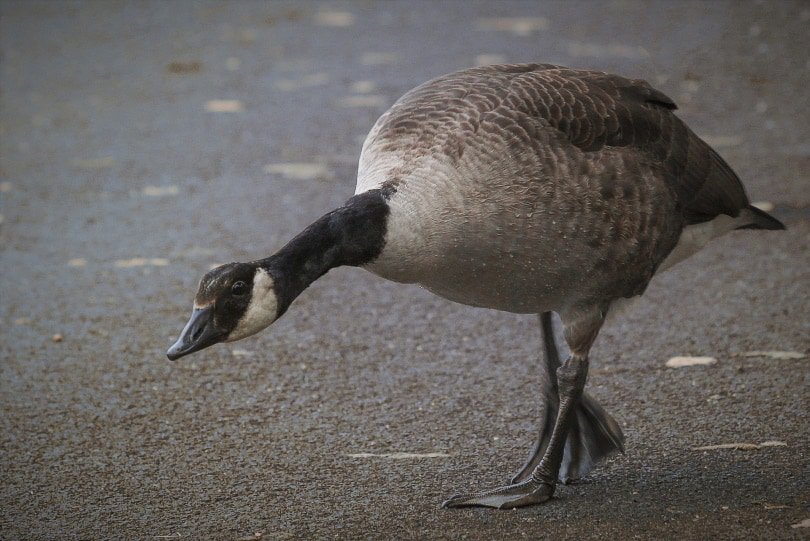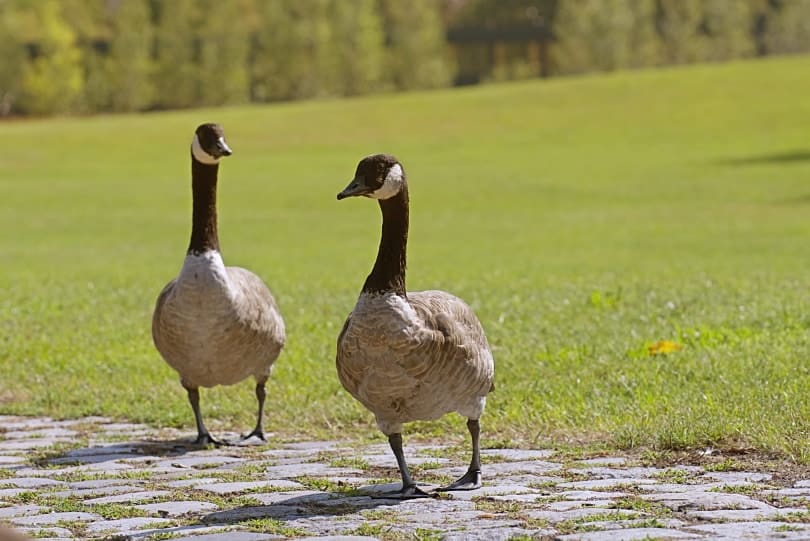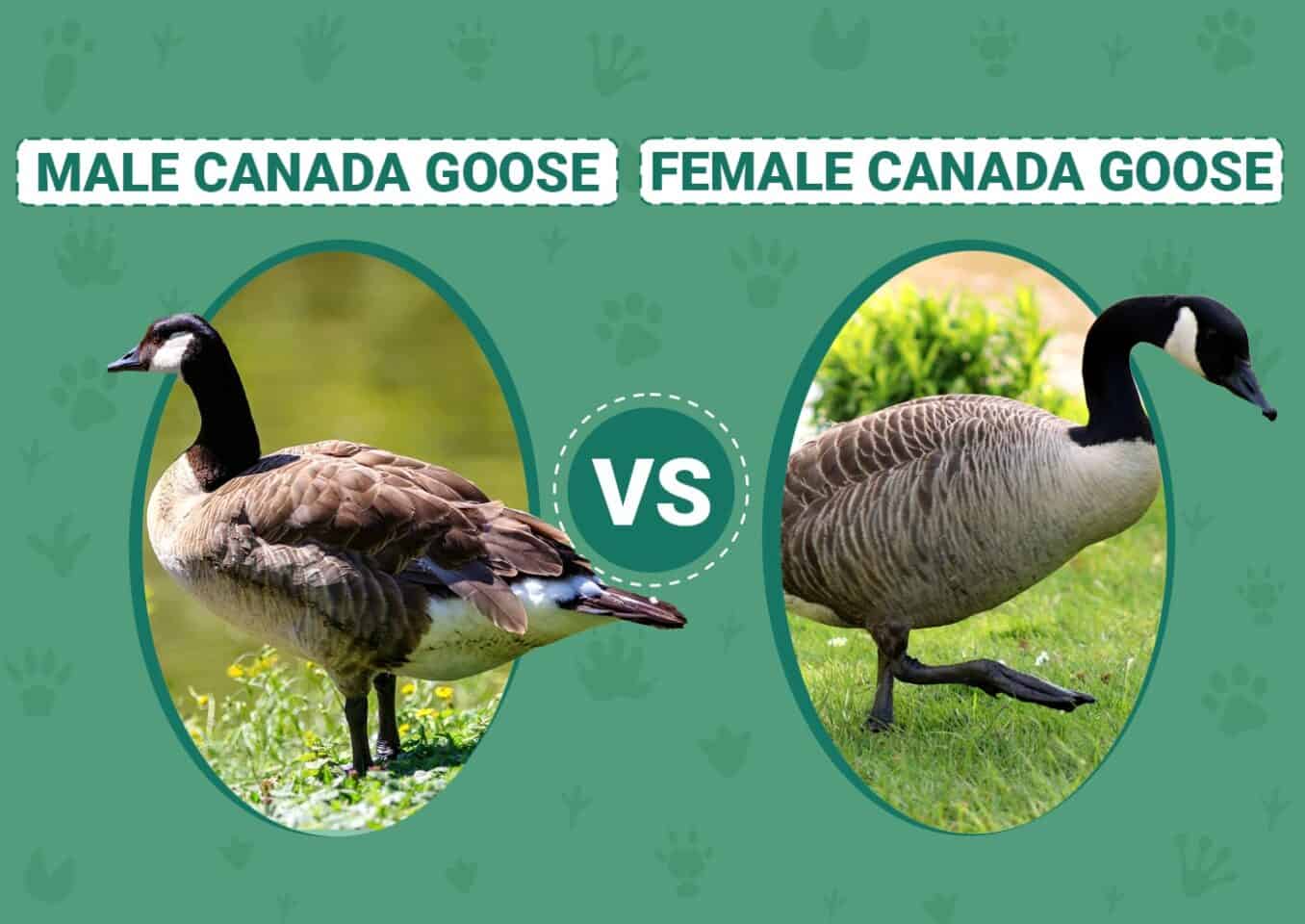Female Canada Goose Overview
The Differences
[/jump-links]
Canada geese (also called Canadian geese) are one of the most popular birds that frequent North America. They are a critical part of wildlife, given their beauty.
They are both primarily herbivorous and migratory birds. Both males and females have established breeding colonies in both cultivated and urban habitats. They nest on the ground, in marshes, or on islands and rivers.
In the wild, Canadian geese mostly eat on grasses, sedges, berries, and grains. In urban areas, they are adept at living off human food and scraps. Their diet consists of waste grain and grasses that grow in aquatic habitats.
These birds tend to look alike and can be strenuous to tell apart. However, through observing their social interactions and behavior, you can learn to distinguish between the sexes.
Here, we’ll explore the male and female Canada geese as well as highlight some notable differences.

Visual Differences

At a Glance
- Origin: Arctic and temperate regions of North America
- Size: 30 to 43 inches in length, 5.5–12 pounds in weight
- Lifespan: 10–24 years
- Domesticated: No
- Origin: Arctic and temperate regions of North America
- Size: 30 to 43 inches in length, 7–14 pounds in weight
- Lifespan: 10–24 years
- Domesticated: No

Male Canada Goose Overview
These large wild geese are native to the arctic and temperate regions of North America. They occasionally migrate across the Atlantic into Northern Europe. They got introduced to Great Britain in the late 18th century and have been popular birds in parks.
Males are generally more aggressive and have a deep honking voice. They also tend to be more territorial. There are some distinct physical features that will help you identify the male. One of the most obvious sign is the size. Males tend to be both larger and heavier.

Male Canada Goose Characteristics & Appearance
Male Canadian geese have a blackhead, a generally black neck with a white patch. The body can vary from light gray to dark brown. The heads are also relatively bigger on average.
They have white cheeks and blackheads with an iridescent sheen. Additionally, their bill is grayish black to bluish-black with a more rounded shape, almost bulbous in appearance.
Their breast feathers are chevron-patterned grey edged in black or white. The back feathers are dark brown or black-white, depending on their subspecies. Also, they spot tail feathers called scapulars and are chestnut brown at the edges, grayish-brown in the center, and pale gray underneath.
Their legs are bluish-black or blackish gray. They have strong toes that help them grip ice surfaces better than most other birds.
Some features get shared between birds of both sexes.


Female Canada Goose Overview
Female Canadian geese are very similar in appearance to the male. For instance, they also bear a white patch on their necks and a slightly nebulous black neck mark that separates them from other species of waterfowl. They also both possess blackheads with lighter-colored backs and chests.
The main ways to tell them apart are through their behavior and size.
Females are generally more docile than males and have a higher-pitched honking voice. They don’t usually chase people or other animals as much as the males do.

Canadian geese are social animals. The preferred habitat of these birds is wetland areas with plenty of grasslands and water bodies nearby. They feed on grasses, aquatic plants, grain crops, berries, fruit, insects, fish, etc.
A group usually consists of five to six goslings, along with a couple of adults, usually male and female. The family works together to protect their young and can be very aggressive when threatened. When winter arrives, they migrate in flocks to warmer climates.
Males and females typically have different behaviors. Females are less territorial and tend to be less aggressive. Females are more likely to leave the territory when threatened. They also gather in flocks to migrate, but the size is usually much smaller.
Female Canada Goose Characteristics & Appearance
While you may not tell the difference from a distance, the females are smaller and have a more slender neck than the males. Although you might not tell the difference just by looking, the female Canadian geese are typically 10% smaller than males. They also weigh less, with about 5.5–12 pounds.
These large, heavy birds have long necks and legs, blackheads with an iridescent sheen. Like their male counterparts, they have grayish-brown wings, white patches on their bellies, and short bills.
Some female Canadian geese also have gray bodies. Furthermore, their wings can be blackish with white along the sides and underneath their primaries (outer wing feathers). They also have a white neck ring and a brownish head.

Female Canada geese can get distinguished by their pointed tail feathers, which are chestnut-brown at the edges. They are also grayish-brown at the center and pale grey underneath.
Additionally, they lack the grayish cast to their head and neck feathers. Their eyes are usually a light brown color. They have blackish-gray legs with webbed feet, which are smaller.
Color variants do exist between genders. However, they are minimal and not easily noticeable. For instance, bills of female birds are dark gray, becoming almost black near the tip.

What Are the Differences Between Male & Female Canada Geese?
Female and male Canadian geese have similarities as far as markings go. The similarities start from sporting back necks and heads to light-colored chests and a white patch on the neck. Unlike mallard ducks, male Canada geese do not have a distinctive plumage that sets them apart from the females.
Some of the noticeable differences between the male and female include:

- Tails: The tails separate the two in terms of visual difference. Male Canada geese possess a rounded tail feather, while the females have pointed one. Young adult geese also have rounded tail feathers, but with a notch to distinguish them from mature males.
- Necks: Although the neck coloration is the same generally, female birds tend to have shorter and slimmer necks. In contrast, male birds have longer and thicker necks. The same applies to their head crowns.
- Size: There are not that many differences between the two sexes, at least not easily identifiable. However, when in a pair, the larger bird is usually the male, though it may not always be the case. A younger male will be smaller than an adult female.

Can You Keep Canada Geese as Pets?
No. Although Canadian geese look like some of your domestic geese, they are still wild birds. Even if kept in captivity, these birds still have a strong sense of migration. They can leave your property at any given moment and return with their flock to their breeding grounds.
If not flying away, it’s possible for Canadian geese to become aggressive with you and other residents in the neighborhood. For this reason, people find them hard to manage as pets.
Apart from aggression, both male and female birds can be dirty and loud. They can also be destructive to property. Although people have hunted them as a protein source for many years, they do not make good pets.
In fact, the federal government has laws protecting the birds against harm (domestication). It’s simply illegal to keep them as pets.
If you want to keep a Canada goose as a pet, you are not in luck. They are best left in the wild where they can live a longer and have a free life.
Featured Image Credit by: Top – Piqsels | Bottom – Pixabay
